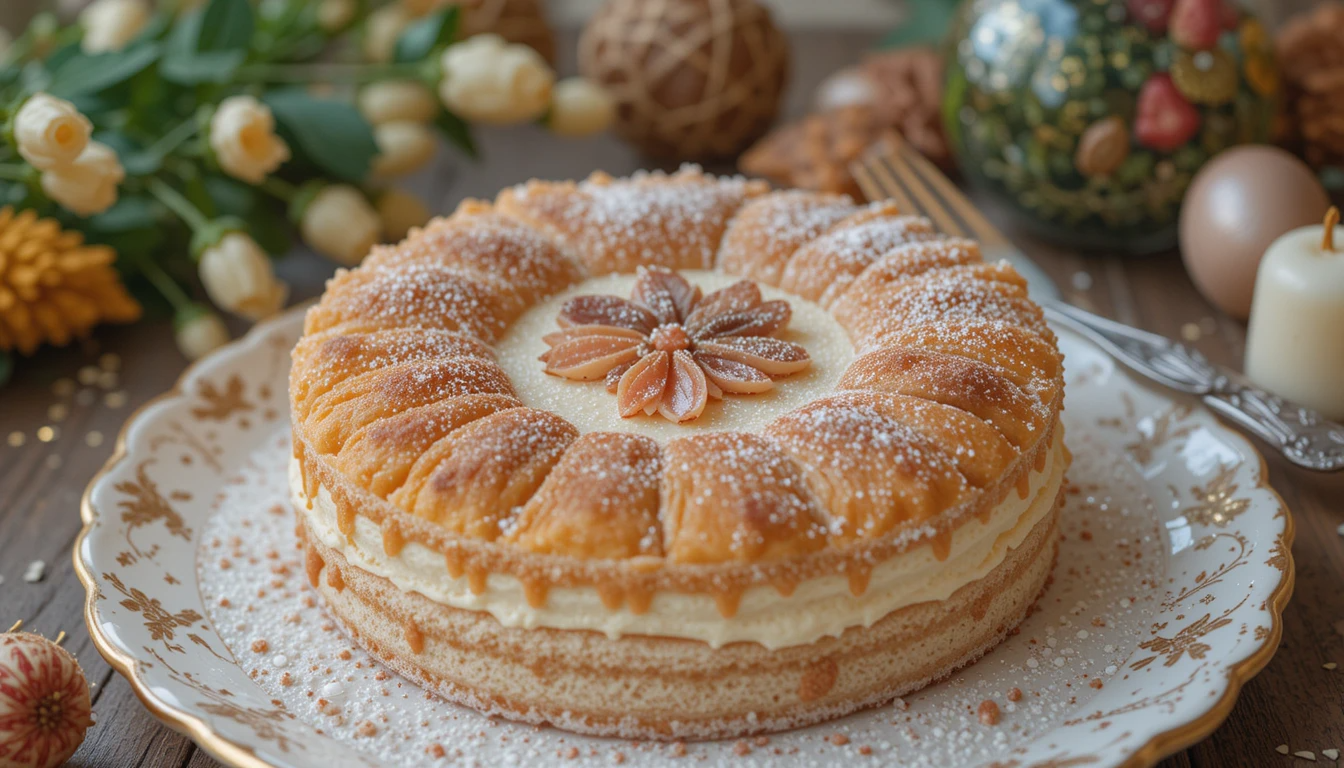
Pastel de Nata is a small, flaky pastry cup filled with creamy egg custard. Historically tied to Lisbon’s Jerónimos Monastery, it has become Portugal’s most famous sweet treat. Whether served warm or at room temperature, Pastel de Nata delivers a blissful harmony of crisp, buttery layers and silky custard.
Table of Contents
Introduction
Close your eyes for a moment and imagine the smell of buttery, flaky pastry layered with a sweet, creamy custard just begging to be tasted. The swirl of cinnamon and sugar dusting the top sends you right into a daydream of European cafés and cobblestone streets. Pastel de Nata carries that promise of indulgence, instantly recognizable for its round shape, golden crust, and caramelized surface. With every bite, you break through a delicate shell to discover a soft, warm center that’s both rich and airy—truly the stuff of dessert dreams.
In this comprehensive guide, we’ll explore the storied history of Pastel de Nata, share detailed tips on how to make them at home, and reveal some modern twists that keep dessert enthusiasts on their toes. Whether you’re a pastry fanatic, a cultural explorer, or simply curious about adding a new sweet treat to your repertoire, you’ll find plenty of valuable insights here. By the end, you’ll be equipped with not only an appreciation for the craft but also the know-how to recreate this world-famous Portuguese treat yourself.
(Disclaimer: This article is for informational purposes only and does not replace professional veterinary advice. Always consult the relevant professionals if you have specific concerns.)
The Storied Origins of Pastel de Nata

From Monastic Kitchens to Global Fame
To truly appreciate Pastel de Nata, you need to trace it back to its monastic beginnings. Legend has it that the recipe emerged in the early 19th century at the Jerónimos Monastery in Lisbon, where monks used egg whites to starch their clothes, leaving an abundance of egg yolks for culinary use. According to Visit Portugal, a reputable tourism resource at the religious orders’ creative approach gave rise to custardy pastries that would become the hallmark of Portuguese cuisine.
- The invention took place near the district of Belém, leading to the popular name Pastéis de Belém for the original.
- After the monastery closed in 1834, resourceful bakers commercialized the recipe.
- The product’s success spread rapidly, and by the late 19th century, Pastel de Nata had garnered a devoted following not just in Lisbon but beyond.
In the early 20th century, as Portuguese immigrants traveled around the globe, they carried their love for Pastel de Nata with them. Today, you can find these custard tarts gracing bakery windows from Toronto to Tokyo, ensuring that new generations discover and savor this historical delight. Despite its long journey, the pastry has remained largely unchanged—still as flaky, buttery, and indulgently custardy as ever.
Symbol of Portuguese Identity
Pastel de Nata is more than just a dessert—it’s a symbol of Portuguese heritage. Walk through the streets of Lisbon, and you’ll find pastry shops serving trays of freshly baked tarts to eager customers at all times of the day. Some locals will insist you taste them still warm from the oven, sprinkled with powdered sugar or cinnamon. Others swear by enjoying them at room temperature to let the flavors meld and intensify.
- Many Portuguese regard Pastel de Nata as a cultural icon, much like France reveres its croissant.
- Travelers often say their visit to Lisbon isn’t complete without trying at least one.
- Families pass down or adapt their own secret recipes, keeping the tradition alive across generations.
This deep emotional and cultural connection underscores the sense of pride surrounding Pastel de Nata. It also explains why newcomers to the pastry often feel they’re participating in something truly special—a culinary rite of passage, of sorts.
Anatomy of a Perfect Pastel de Nata
Flaky, Buttery Pastry Shell
One glance at Pastel de Nata reveals a delicate, golden-brown crust that beckons you to take a closer look. This layered pastry shell is reminiscent of puff pastry—crisp on the outside, slightly chewy within. Achieving that texture often involves folding butter into the dough multiple times or using a ready-made puff pastry as a shortcut.
- Laminated Dough: Traditional recipes call for hand-laminating the dough, which creates that signature swirl when you slice into the pastry.
- Crunch vs. Chew: The best Pastel de Nata strike a balance between crisp edges and tender layers, ensuring that every bite offers a light, flaky resistance.
- Golden Color: Proper baking is crucial. Under-baking yields a pale crust lacking flavor depth, while over-baking risks a bitter, burned edge.
The pastry shell is the gateway to everything else that makes Pastel de Nata extraordinary. When well-prepared, it plays off the custard’s smoothness, creating a textural experience that’s nothing short of addicting.
Silky, Egg-Based Custard
The second defining component is the custard itself—velvety, creamy, and delicately sweet. Typically, it combines egg yolks, sugar, milk (or cream), and sometimes a touch of flour or cornstarch for thickening. The filling is cooked on the stovetop before being poured into the pastry cups and baked until it develops a caramelized surface.
- Subtle Flavor: Since eggs dominate the custard, the sweetness is mild rather than overpowering.
- Creamy Consistency: Achieving a silky texture requires careful attention to temperature control and stirring.
- Caramelized Top: The hallmark of a genuine Pastel de Nata is a slightly blistered or caramelized top, adding both color and a hint of roasty flavor.
When the custard meets the pastry in the oven, the two transform into a single, harmonious bite. This makes the artistry behind Pastel de Nata unique: you’re not just baking a pie shell and pouring in custard. You’re letting them merge and shape each other’s texture to create a layered, but cohesive, dessert experience.
Techniques and Tips for Homemade Pastel de Nata

The Right Ingredients
If you’re aiming to make your own Pastel de Nata, ingredient quality can make a huge difference. High-quality butter ensures a pastry that is both flaky and richly flavored. Using fresh, free-range egg yolks helps impart that lovely golden tone and lush mouthfeel. Here’s a basic list of what you’ll need:
- 1 roll of puff pastry dough (store-bought or homemade)
- 1 cup whole milk
- 3–4 egg yolks
- ¾ cup granulated sugar
- 2 tablespoons all-purpose flour (or cornstarch)
- ½ cup water
- 1 cinnamon stick (optional)
- Zest of 1 lemon (optional)
While the exact proportions can vary, these staples provide a solid starting point for a classic version of Pastel de Nata. Some bakers prefer cream to milk for a richer custard, while others enjoy infusing the liquid with a cinnamon stick or citrus peels for an aromatic twist.
Step-by-Step Preparation
- Preheat & Prep: Preheat your oven to about 475°F (245°C). Grease a muffin tin or custard tart tray.
- Form the Pastry Cups: Cut the puff pastry into small circles, roll them slightly if needed, and place each into the muffin wells. Chill in the refrigerator while you prepare the custard.
- Cook the Custard Base: In a saucepan, whisk together sugar, flour (or cornstarch), and water until smooth. Add milk and a cinnamon stick (if desired). Bring to a gentle simmer while stirring constantly. Remove from heat, and slowly incorporate egg yolks.
- Pour & Bake: Fill the chilled pastry cups with the warm custard mixture. Bake in the preheated oven for about 15–18 minutes, or until the tops begin to caramelize and develop dark spots.
- Cool Slightly: Allow the pastries to cool in the tin for a few minutes before transferring them to a wire rack. This step helps the custard set and prevents burning your fingers.
- Enjoy Fresh: Although Pastel de Nata can be eaten at room temperature, many enthusiasts—myself included—believe they’re best devoured slightly warm.
Common Pitfalls
- Over-Filling: If you pour in too much custard, it may bubble over and burn onto the pan, creating a bitter residue.
- Under-Baking the Pastry: Ensure that the pastry layers cook thoroughly, or you risk a soggy base.
- Rapid Cooling: Avoid drastic temperature changes. Letting the pastries cool slowly helps maintain their structure and texture.
By paying attention to these details, you’ll find yourself well on the way to mastering Pastel de Nata at home.
Modern Twists on Pastel de Nata
Flavored Custards
While traditional Pastel de Nata thrives on a plain custard base, modern pastry chefs love experimenting.
- Chocolate Swirl: Some swirl melted chocolate into the custard for a subtle cocoa accent.
- Coffee-Infused: A dash of espresso or strong coffee can impart a mocha-like element.
- Fruit Purees: Berry or passion fruit purees add a zingy sweetness that balances the richness of the egg yolks.
These flavor variations demonstrate how versatile Pastel de Nata can be while still retaining its core identity of flaky pastry and creamy interior.
Savory Adaptations
A handful of chefs and adventurous home cooks have toyed with the idea of savory Pastel de Nata. While it may sound unorthodox, consider the structure: a puff pastry shell filled with an egg-based mixture. Replace sugar with cheese, herbs, or even chopped vegetables, and you could have a mini quiche. Although these savory spin-offs stray far from tradition, they capture the spirit of creative exploration that keeps the dish evolving.
- Spinach & Cheese: A mixture of spinach, ricotta, and egg, baked in the same crisp shell.
- Caramelized Onion & Goat Cheese: Adds a sweet-savory depth reminiscent of French onion tarts.
- Herbed Egg Whites: For a lighter option, some experiment with egg whites and fresh herbs, though it’s undeniably less indulgent than the classic.
While these adaptations aren’t typically labeled as Pastel de Nata, they highlight just how universal the technique behind the pastry can be.
Pastel de Nata Around the World
Today, Pastel de Nata is not confined to Portugal’s borders. You’ll find variations and near-copies in many places, each adding a local twist.
- Macau: Formerly a Portuguese colony, Macau introduced Chinese influences to the pastry. Locals often refer to it as a Portuguese Egg Tart, with slightly different taste nuances due to heavier caramelization.
- Brazil: Portuguese cuisine left an indelible mark here, so Pastel de Nata frequently appears in Brazilian bakeries.
- United Kingdom: Pastry shops and supermarkets stock them to meet the growing demand among adventurous foodies.
- North America: Popular in regions with significant Portuguese or Brazilian communities, especially in cities like Toronto and Boston.
In each location, the dessert retains its fundamental identity—flaky pastry and creamy custard—while embracing subtle local preferences, whether in sweetness, use of spices, or serving temperature.
Table: Variations of Pastel de Nata Around the Globe
Below is an overview of how different regions put their own spin on the classic Pastel de Nata:
| Region | Local Name/Variation | Key Difference | Typical Service |
|---|---|---|---|
| Portugal (Lisbon) | Pastéis de Belém | Original recipe from Jerónimos Monastery | Warm, with powdered sugar or cinnamon |
| Macau | Portuguese Egg Tart | Heavier caramelization, sometimes sweeter | Eaten both hot and cold, often in cafés |
| Brazil | Pastel de Nata / Empadinha Doce | Similar to Portuguese version but sometimes less sweet | Street stalls, bakeries, or café chains |
| United Kingdom | Portuguese Custard Tart | Slightly adapted to local taste; often extra sweet | Grocery stores, bakery shops, coffee houses |
| North America | Pastel de Nata (various shops) | Varies by local baker’s choice of dough & custard | Often part of a breakfast or brunch spread |
While the essentials remain the same—egg custard plus flaky pastry—regional preferences and interpretations can shift the flavor profile. Regardless of these differences, the common thread is the universal appeal of sweet, creamy comfort wrapped in a crisp shell.
The Cultural Ritual of Enjoying Pastel de Nata
Warm vs. Room Temperature
One of the most debated topics among Pastel de Nata aficionados is whether to eat them warm or at room temperature. Purists swear that a slightly warm tart offers the best textural contrast: the filling is still soft and custardy, while the pastry remains crisp. Others argue that letting them cool allows the flavors to blend, resulting in a cohesive bite that’s sweet, creamy, and aromatic without the risk of burning your tongue.
- Pro-Warm: “If you can still feel the steam rising, you’ve caught them at their best.”
- Pro-Room Temperature: “All the flavors have had time to settle and deepen.”
- In-Between?: A quick, gentle reheat in the oven can please everyone, offering warmth while preserving texture.
Whichever method you choose, the experience is undeniably delightful. For the sake of curiosity, try them both ways and see which approach wins you over.
Pairings and Beverages
Many people enjoy Pastel de Nata with a hot beverage, like coffee or tea. The mild bitterness of coffee cuts through the richness of the custard, while tea can offer an herbal or floral note to complement the pastry.
- Espresso: Provides a robust, bittersweet contrast.
- Cappuccino or Latte: Layers of milk echo the creamy custard.
- Black Tea or Green Tea: Offers a subtler pairing, letting the pastry shine without heavy competition.
For those who enjoy an adult beverage, a glass of sweet white wine—like a late-harvest Riesling—or even a port wine can add a festive touch. If you’re more of a fruit juice person, something slightly tangy like orange or grapefruit juice creates a bright flavor foil for the custard.
Health Considerations and Moderation

Nutritional Snapshot
While Pastel de Nata is undeniably delicious, it’s essential to acknowledge its nutritional profile. A single tart (around 60–80 grams) can contain anywhere from 180 to 270 calories, depending on the recipe and size. This comes from the buttery pastry and the sugar and egg yolk-laden custard.
- Fats: Primarily from butter in the pastry, often making up a significant share of the calorie count.
- Carbohydrates: Sugar and refined flour drive up the carbohydrate content.
- Proteins: Eggs contribute some protein, though not enough to make these pastries a “health food.”
Strategies for Enjoyment
If you’re keen to savor Pastel de Nata without overdoing it, a bit of moderation can go a long way. Instead of indulging in several tarts at once, enjoy one as a satisfying treat. You can also consider sharing with a friend, or pairing your tart with fruit or a lighter meal to maintain balance throughout the day.
- Portion Control: One or two tarts as an occasional treat, rather than a daily habit.
- Baked vs. Fried: While the pastry is baked, it’s still high in fat—be aware of overall daily intake.
- Physical Activity: A brisk walk after indulging can help you feel better balanced.
From a nutritional perspective, Pastel de Nata stands as an indulgent treat. Incorporating it responsibly into your diet allows you to relish the experience without straying too far from health goals.
(Disclaimer: This information is for educational purposes and does not replace personalized medical or nutritional advice. Consult a healthcare professional for individualized guidance.)
Expert Opinions and Real-Life Anecdotes
Culinary Authorities
Renowned chefs like José Avillez and other Portuguese culinary experts frequently applaud Pastel de Nata for its marriage of simplicity and sophistication. According to local pastry chefs in Lisbon, controlling the oven temperature precisely is one of the biggest challenges: the heat must caramelize the custard top without scorching the pastry edges. These nuances make Pastel de Nata deceptively tricky, highlighting the skill it takes to replicate the texture found in the best Lisbon cafés.
Personal Experiences
From personal experience, my most memorable Pastel de Nata moment happened in Lisbon’s Belém district, just a short walk from the Tagus River. The bakery I visited had lines out the door, but the wait was worth every second. Biting into that fresh-from-the-oven tart, I was floored by the interplay of the warm, custardy center with the crisp, flaky rim—a sensation that lived up to every bit of the dessert’s legendary reputation.
Others share similar stories, often recounting how the subtle aroma of cinnamon or the perfect pairing of an espresso elevated the moment from a mere snack to a gastronomic adventure. The passion people have for Pastel de Nata underscores its place in the pantheon of iconic global pastries.
FAQs
What is pastel de nata made of?
Pastel de Nata consists of a flaky pastry shell filled with a creamy egg custard. It typically uses eggs, sugar, milk, and sometimes cream or flour. The pastry bakes until the custard caramelizes, giving Pastel de Nata its signature golden top.
Do you eat pastel de nata warm or cold?
Most people enjoy Pastel de Nata slightly warm for a crisp crust and silky filling. Others prefer it at room temperature to allow the flavors to settle. Either way, Pastel de Nata is delectable, so pick what you like best.
What is the difference between egg custard and pastel de nata?
A basic egg custard is often baked in a single crust or dish, while Pastel de Nata has a laminated puff pastry shell. Pastel de Nata also features caramelized spots on top and a distinct Portuguese flair. That crispy, flaky pastry sets Pastel de Nata apart from typical custard tarts.
Is pastel de nata like creme brulee?
While both have sweet, creamy centers, Pastel de Nata includes a flaky pastry shell. Crème brûlée is typically served in a ramekin with a hard caramel top. Pastel de Nata relies on a caramelized egg custard filling that bakes directly in pastry cups.
Conclusion
For a dessert that began in a humble monastic kitchen, Pastel de Nata has come a long way, captivating sweet tooths around the globe. From the delicate layers of butter-laminated dough to the luscious egg custard crowned with caramelized spots, each element weaves together to create an unforgettable bite. Whether you’re savoring it on a sunlit patio in Lisbon, whipping up a batch in your own kitchen, or exploring its global variations, Pastel de Nata remains a testament to Portugal’s pastry prowess.
As you embark on your journey with Pastel de Nata, remember that creativity, quality ingredients, and patient technique can yield a pastry that leaves a lasting impression. Try experimenting with temperatures, flavors, or even savory adaptations if you dare. Ultimately, this classic dessert invites you to partake in a little taste of Portugal wherever you are—one delicious mouthful at a time.
Key Takeaways
- Pastel de Nata originated in Lisbon’s Jerónimos Monastery, spreading worldwide over time.
- The pastry’s success hinges on the crisp, buttery shell and silky custard.
- Variations exist, from chocolate or coffee flavors to full-blown savory experiments.
- Whether eaten warm or cool, Pastel de Nata remains an iconic Portuguese dessert.
- Moderation is key; these rich tarts can be part of a balanced diet in small quantities.
- Experimenting at home can be rewarding, but it requires attention to detail.
